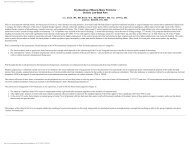Atlas of the muscle motor points for the lower limb: implications for ...
Atlas of the muscle motor points for the lower limb: implications for ...
Atlas of the muscle motor points for the lower limb: implications for ...
You also want an ePaper? Increase the reach of your titles
YUMPU automatically turns print PDFs into web optimized ePapers that Google loves.
Eur J Appl Physiol (2011) 111:2461–2471 2465<br />
Fig. 1 Position <strong>of</strong> <strong>the</strong> <strong>motor</strong> <strong>points</strong> <strong>for</strong> <strong>the</strong> quadriceps <strong>muscle</strong>s in 53<br />
healthy subjects. The arrows indicate <strong>the</strong> average positions <strong>of</strong> <strong>the</strong><br />
<strong>motor</strong> <strong>points</strong> along <strong>the</strong> respective reference lines. a Motor <strong>points</strong><br />
identified in <strong>the</strong> vastus lateralis (blue circles, proximal <strong>motor</strong> point;<br />
white circles, central <strong>motor</strong> point; yellow circles, distal <strong>motor</strong> point).<br />
Continuous black line is <strong>the</strong> reference line <strong>for</strong> <strong>the</strong> proximal <strong>motor</strong><br />
point, while dashed black line is <strong>the</strong> reference line <strong>for</strong> <strong>the</strong> central and<br />
Two different <strong>motor</strong> <strong>points</strong> were identified in all subjects<br />
<strong>for</strong> <strong>the</strong> vastus medialis <strong>muscle</strong>: a proximal <strong>motor</strong><br />
point (blue circles in Fig. 1c) and a distal <strong>motor</strong> point<br />
(yellow circles in Fig. 1c). Proximal and distal stimulation<br />
excited fibers <strong>of</strong> <strong>the</strong> longus and obliquus portions <strong>of</strong> <strong>the</strong><br />
<strong>muscle</strong>, respectively.<br />
Two different <strong>motor</strong> <strong>points</strong> were identified in all subjects<br />
<strong>for</strong> <strong>the</strong> biceps femoris <strong>muscle</strong>: stimulation <strong>of</strong> <strong>the</strong><br />
proximal <strong>motor</strong> point excited fibers <strong>of</strong> <strong>the</strong> long head<br />
(Fig. 2a), whereas stimulation <strong>of</strong> <strong>the</strong> distal <strong>motor</strong> point<br />
excited fibers <strong>of</strong> <strong>the</strong> short head (Fig. 2b).<br />
Two different <strong>motor</strong> <strong>points</strong> were identified (by visual<br />
inspection and manual palpation <strong>of</strong> <strong>the</strong> <strong>muscle</strong> and its distal<br />
tendon during stimulation) in 52 out <strong>of</strong> 53 subjects <strong>for</strong> <strong>the</strong><br />
tibialis anterior <strong>muscle</strong>: stimulation <strong>of</strong> <strong>the</strong> proximal <strong>motor</strong><br />
point (blue circles in Fig. 3a) excited fibers located<br />
superficially and medially to <strong>the</strong> reference line, whereas<br />
stimulation <strong>of</strong> <strong>the</strong> distal <strong>motor</strong> point (yellow circles in<br />
Fig. 3a) excited fibers located deeply and laterally to <strong>the</strong><br />
reference line.<br />
One <strong>motor</strong> point was identified in all subjects <strong>for</strong> <strong>the</strong><br />
o<strong>the</strong>r <strong>muscle</strong>s investigated: semitendinosus (Fig. 2c),<br />
distal <strong>motor</strong> point. b Motor <strong>points</strong> identified in <strong>the</strong> rectus femoris<br />
(blue circles, proximal <strong>motor</strong> point; yellow circles, distal <strong>motor</strong><br />
point). c Motor <strong>points</strong> identified in <strong>the</strong> vastus medialis (blue circles,<br />
proximal <strong>motor</strong> point; yellow circles, distal <strong>motor</strong> point). Continuous<br />
black line is <strong>the</strong> reference line <strong>for</strong> <strong>the</strong> proximal <strong>motor</strong> point, while<br />
dashed black line is <strong>the</strong> reference line <strong>for</strong> <strong>the</strong> distal <strong>motor</strong> point<br />
semimembranosus (Fig. 2d), peroneus longus (Fig. 3b),<br />
medial (blue circles in Fig. 3c) and lateral gastrocnemius<br />
(yellow circles in Fig. 3c).<br />
An important inter-individual variability was observed<br />
<strong>for</strong> <strong>the</strong> position <strong>of</strong> <strong>the</strong> following 4 out <strong>of</strong> 16 <strong>motor</strong><br />
<strong>points</strong> (‘‘poor’’ uni<strong>for</strong>mity <strong>of</strong> <strong>the</strong> <strong>motor</strong> point position):<br />
vastus lateralis (proximal), biceps femoris (short head),<br />
semimembranosus, and medial gastrocnemius. On <strong>the</strong><br />
contrary, low variability was observed <strong>for</strong> <strong>the</strong> following<br />
4 out <strong>of</strong> 16 <strong>motor</strong> <strong>points</strong> (‘‘good’’ uni<strong>for</strong>mity <strong>of</strong> <strong>the</strong><br />
<strong>motor</strong> point position): vastus lateralis (distal), vastus<br />
medialis (proximal and distal), and peroneus longus<br />
(Table 2).<br />
Discussion<br />
Sixteen <strong>motor</strong> <strong>points</strong> were identified as maximum number<br />
in each subject and <strong>the</strong> uni<strong>for</strong>mity <strong>of</strong> <strong>the</strong>ir position along<br />
<strong>the</strong> respective reference lines was quantified <strong>for</strong> ten <strong>lower</strong><br />
<strong>limb</strong> <strong>muscle</strong>s. Quadriceps and tibialis anterior <strong>muscle</strong>s<br />
showed two or three <strong>motor</strong> <strong>points</strong> innervating different<br />
123






